Atlassian Bundle
Who Does Atlassian Serve?
Understanding Atlassian's customer demographics and target market is crucial for grasping its impressive growth trajectory. Initially focused on software developers, Atlassian has strategically broadened its reach. This expansion showcases a dynamic adaptation to serve a wider array of business teams, making it a key player in the collaborative software space.
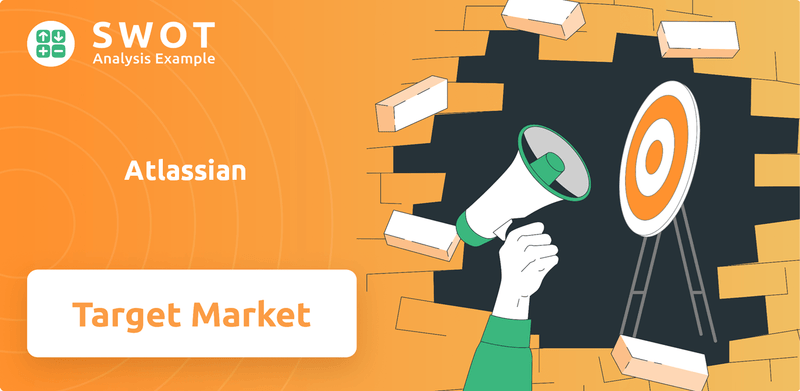
Atlassian's Atlassian SWOT Analysis reveals how understanding its customer profile has fueled its success. The company's ability to identify and cater to the evolving needs of its Atlassian users, from small businesses to large enterprises, is a testament to its customer-centric approach. This analysis delves into the specifics of Atlassian's customer segmentation analysis, examining its ideal customer persona, geographic location, industry breakdown, and more, offering valuable insights into its customer acquisition and retention strategies.
Who Are Atlassian’s Main Customers?
Understanding the customer demographics of companies like Atlassian is crucial for grasping their market position and growth strategies. Atlassian primarily operates in the B2B sector, focusing on organizations of varying sizes. Its Atlassian target market encompasses a broad spectrum of professionals across different departments, not just technical teams.
The Atlassian customer profile has evolved over time, reflecting changes in product offerings and market demands. Originally, the company's core users were software developers and IT professionals. However, Atlassian has successfully expanded its reach to include non-technical teams, showcasing its ability to adapt to the evolving needs of its Atlassian audience.
The company's success is evident in its enterprise presence, with over 80% of Fortune 500 companies using its products. This expansion into the broader enterprise market has been a significant driver of growth, diversifying revenue streams. Further insights into Atlassian's business model can be found in this article: Revenue Streams & Business Model of Atlassian.
Historically, Atlassian's initial Atlassian users were predominantly software developers, IT professionals, and technical teams. These teams utilized products like Jira for project management and Bitbucket for code management. This segment formed the foundation of Atlassian's customer base.
Over time, Atlassian expanded its reach to include non-technical teams. This shift was driven by the adoption of Confluence for knowledge sharing and Trello for visual project management. This expansion broadened the Atlassian clients base.
Atlassian has seen significant growth in the enterprise segment. The company's ability to penetrate non-technical teams within large organizations has been a key factor. This growth is also supported by the fact that over 80% of Fortune 500 companies use Atlassian products.
Market research played a crucial role in Atlassian's expansion strategy. The research highlighted the need for improved team collaboration and workflow management. This led to the development of solutions that cater to diverse business functions.
Atlassian's primary customer segments include software development teams, IT professionals, and non-technical teams such as marketing, HR, legal, and finance departments. The company's focus on teamwork and work management solutions has facilitated this expansion.
- Software Development Teams: Utilizing Jira and Bitbucket.
- IT Professionals: Managing projects and infrastructure.
- Marketing Teams: Using Confluence and Trello for collaboration.
- HR, Legal, and Finance: Adopting Atlassian products for various workflows.
Atlassian SWOT Analysis
- Complete SWOT Breakdown
- Fully Customizable
- Editable in Excel & Word
- Professional Formatting
- Investor-Ready Format
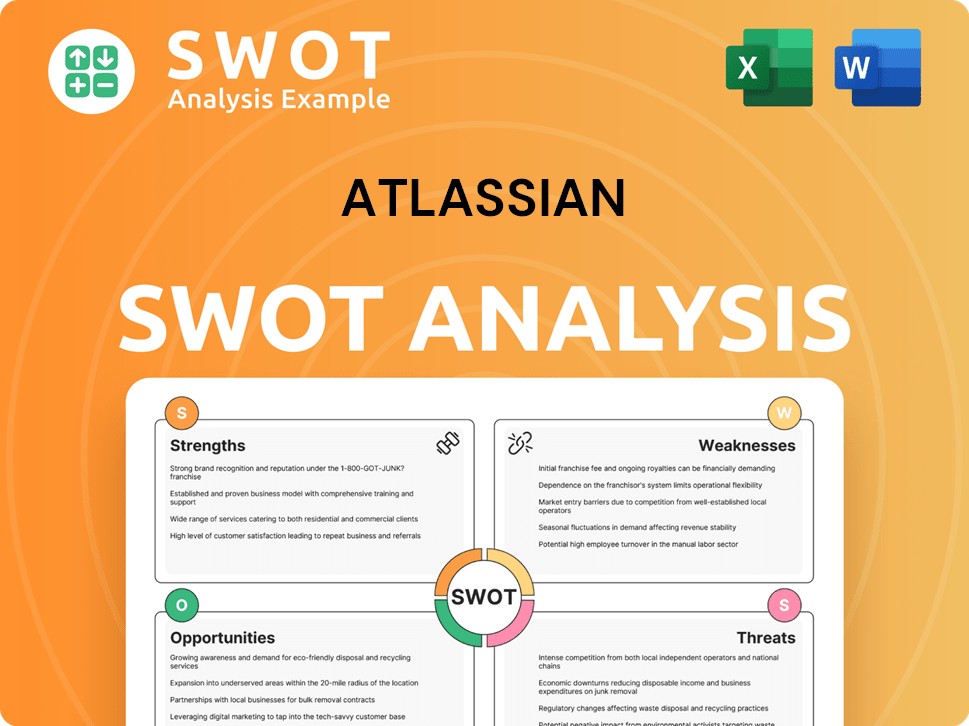
What Do Atlassian’s Customers Want?
The core of Atlassian's success lies in its ability to meet the evolving needs of its customers. The company's products, such as Jira and Confluence, are designed to enhance team collaboration, streamline workflows, and boost overall productivity. Understanding the customer demographics and the Atlassian target market is crucial for tailoring solutions that resonate with their needs.
Atlassian's clients are often driven by the desire for integrated solutions that can manage complex projects and facilitate seamless communication. Decision-making criteria frequently include ease of integration with existing systems, scalability, and a robust feature set. The company's focus on agile methodologies and customizable workflows further addresses the practical needs of its customers. Their products are designed to address common pain points such as disjointed communication and lack of project visibility.
The psychological drivers for choosing Atlassian's offerings often stem from a desire for transparency, efficiency, and empowerment within teams. Customer feedback, gathered through various channels, significantly influences product development. Atlassian tailors its marketing by emphasizing teamwork and problem-solving, enhancing the overall customer experience.
Atlassian's products are designed to foster better teamwork.
The platform helps to simplify and automate processes.
Users aim to achieve higher efficiency and output.
Customers seek tools that work together seamlessly.
The platform provides tools for project oversight.
Confluence helps with centralized documentation.
The Atlassian user base is diverse, spanning various industries and company sizes. The company's products cater to both small businesses and large enterprises, with features that scale to meet different needs. For instance, in fiscal year 2024, Atlassian reported over 300,000 customers globally, demonstrating its broad appeal. Understanding the Atlassian customer profile involves analyzing their needs, pain points, and buying behaviors. For further insights, you can explore the perspectives of Owners & Shareholders of Atlassian.
Atlassian's customers prioritize ease of use, integration capabilities, and scalability. They seek solutions that enhance team collaboration, improve project management, and streamline workflows. Key preferences include:
- Robust project management features
- Seamless integration with other tools
- Customizable workflows
- Efficient knowledge sharing capabilities
Atlassian PESTLE Analysis
- Covers All 6 PESTLE Categories
- No Research Needed – Save Hours of Work
- Built by Experts, Trusted by Consultants
- Instant Download, Ready to Use
- 100% Editable, Fully Customizable
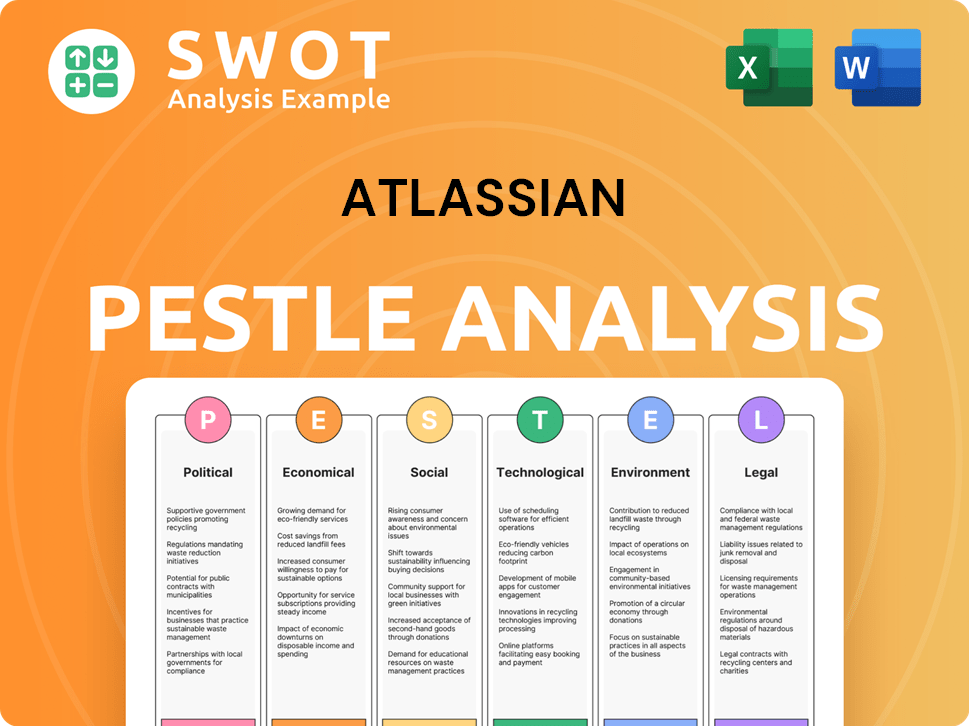
Where does Atlassian operate?
The geographical market presence of Atlassian is robust and globally distributed. The company has a significant footprint in North America, Europe, and the Asia-Pacific region. The United States and Australia, where Atlassian originated, are key markets with strong brand recognition. This widespread adoption signifies a diverse Atlassian customer profile across various countries.
Atlassian's sales are globally distributed, with a substantial portion of revenue generated outside its home country. This global reach is supported by localized marketing efforts and customer support. The company adapts its approach to address differences in customer preferences and buying power across different regions. For example, while agile development is a global trend, Atlassian may emphasize specific compliance or data residency requirements to better resonate with local markets.
Recent expansions have focused on deepening its presence in key international markets. This is often achieved through strategic partnerships and cloud infrastructure investments to ensure localized performance and data sovereignty. The geographic distribution of sales and growth continues to be robust across its primary markets. Atlassian is also making ongoing efforts to expand into emerging economies as digital transformation accelerates worldwide, demonstrating a proactive approach to reaching a broader Atlassian audience.
North America, Europe, and Asia-Pacific are the primary geographical markets for Atlassian. The United States and Australia are particularly significant due to their strong market share and brand recognition.
Atlassian tailors its marketing and support to address regional differences in customer preferences and buying behaviors. This includes highlighting specific use cases and integrating with region-specific tools.
Recent expansions focus on deepening the company's presence in key international markets. Strategic partnerships and cloud infrastructure investments support these efforts.
A substantial portion of Atlassian's revenue comes from outside its home country, reflecting its global reach. This indicates the widespread adoption of its products.
Atlassian's primary markets include North America, Europe, and the Asia-Pacific region. The United States and Australia are particularly important.
The company adapts its marketing and product offerings to suit local preferences and regulations. This approach helps resonate with diverse Atlassian users.
Atlassian utilizes strategic partnerships to expand its global footprint. These collaborations support market penetration and customer acquisition.
Investments in cloud infrastructure ensure localized performance and data sovereignty. This is essential for meeting regional compliance requirements.
Atlassian is actively expanding into emerging economies. This expansion aligns with the global trend of digital transformation.
A significant portion of Atlassian's revenue comes from outside its home country. This highlights its global reach and customer base.
Atlassian's global presence is marked by strong market share in key regions and a focus on localization. The company's strategic approach includes partnerships and cloud infrastructure investments to support international growth.
- Strong presence in North America, Europe, and Asia-Pacific.
- Localized marketing and support to address regional differences.
- Strategic partnerships and cloud infrastructure investments.
- Expansion into emerging economies.
- Significant revenue generated outside of the home country.
Atlassian Business Model Canvas
- Complete 9-Block Business Model Canvas
- Effortlessly Communicate Your Business Strategy
- Investor-Ready BMC Format
- 100% Editable and Customizable
- Clear and Structured Layout
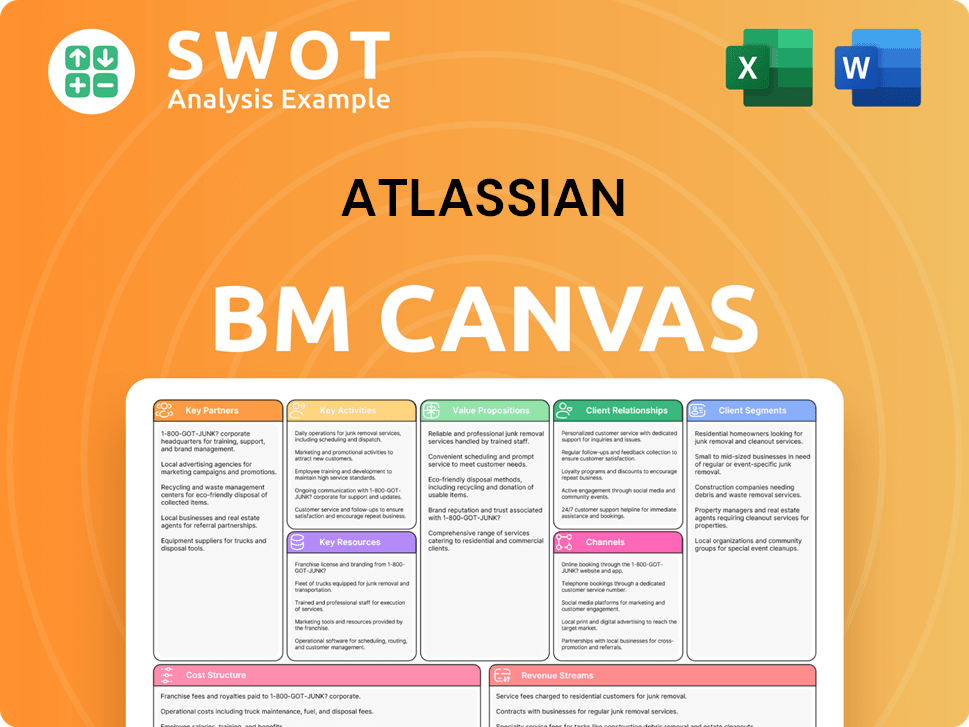
How Does Atlassian Win & Keep Customers?
The company's customer acquisition and retention strategies are heavily influenced by its product-led growth model. This approach emphasizes the value of its products, which drives organic adoption and word-of-mouth referrals. Digital marketing, including SEO, content marketing, and online advertising, plays a crucial role in attracting new users. This strategy helps in reaching a wide range of potential customers.
A freemium model allows potential customers to try out the software at no cost, which often leads to paid subscriptions as their needs grow. The company's Marketplace, which offers third-party apps and integrations, enhances product stickiness and draws in new users. These strategies are designed to create a strong and loyal customer base.
For customer retention, the company focuses on continuous product improvement, excellent customer support, and fostering a strong user community. They use customer data and CRM systems to understand usage patterns and identify opportunities for upselling or cross-selling. Personalized experiences, such as tailored product recommendations and educational content, also contribute to customer loyalty.
Word-of-mouth is a significant driver of new customer acquisition, fueled by the reputation and utility of its core products. This organic growth is cost-effective and builds trust. The company's focus on delivering high-quality products naturally encourages users to recommend them to others.
Digital marketing, including SEO, content marketing (blogs, whitepapers, case studies), and online advertising, is essential. These channels help attract new users by increasing visibility and providing valuable information. Effective digital strategies are crucial for reaching the target market.
The freemium model allows users to try the software at no cost, which often leads to paid subscriptions. This approach lowers the barrier to entry and allows users to experience the value of the products. As users' needs grow, they often upgrade to paid plans.
The Atlassian Marketplace provides third-party apps and integrations, enhancing product functionality and attracting new users. This ecosystem increases product stickiness and provides added value. It also expands the products' capabilities to meet diverse user needs.
The company's customer retention strategies include continuous product improvement, excellent customer support, and a strong user community. They use customer data and CRM systems to understand usage patterns and identify opportunities for upselling or cross-selling. Personalized experiences, such as tailored product recommendations and educational content, also contribute to customer loyalty. For more details on their marketing approach, consider reading about the Marketing Strategy of Atlassian.
Regular product updates and enhancements are crucial for retaining customers. This includes new features, bug fixes, and performance improvements. Continuous improvement ensures that the products remain competitive and meet evolving user needs.
Providing excellent customer support is essential for customer retention. This includes responsive support channels, helpful documentation, and a knowledge base. High-quality support helps resolve issues quickly and builds customer loyalty.
Fostering a strong user community encourages engagement and provides a platform for users to share knowledge and support each other. This community aspect enhances product value and fosters loyalty. User conferences like Team '24 engage existing customers.
Using customer data and CRM systems to understand usage patterns allows for targeted upselling and cross-selling. This approach helps customers discover additional features and products that meet their needs. This strategy increases customer lifetime value.
Personalized product recommendations and educational content enhance customer loyalty. Tailoring the experience to individual needs ensures that users feel valued and supported. This strategy helps in building long-term relationships.
The shift towards a cloud-first strategy has impacted customer lifetime value by encouraging ongoing subscriptions and reducing churn. This approach provides greater flexibility and scalability. This strategic move emphasizes recurring revenue streams.
Atlassian Porter's Five Forces Analysis
- Covers All 5 Competitive Forces in Detail
- Structured for Consultants, Students, and Founders
- 100% Editable in Microsoft Word & Excel
- Instant Digital Download – Use Immediately
- Compatible with Mac & PC – Fully Unlocked
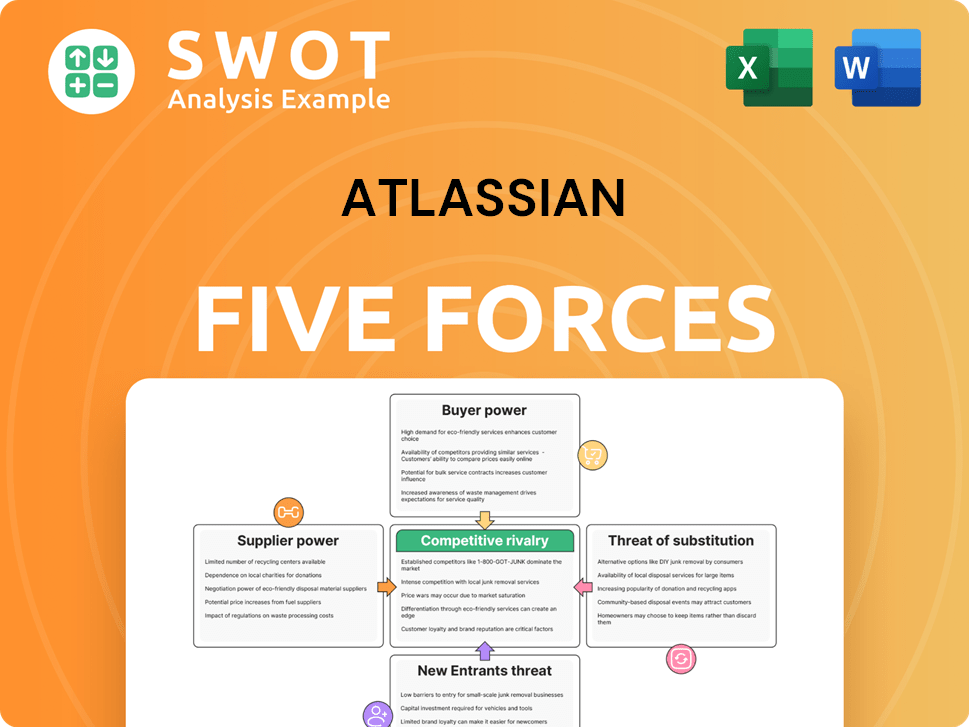
Related Blogs
- What are Mission Vision & Core Values of Atlassian Company?
- What is Competitive Landscape of Atlassian Company?
- What is Growth Strategy and Future Prospects of Atlassian Company?
- How Does Atlassian Company Work?
- What is Sales and Marketing Strategy of Atlassian Company?
- What is Brief History of Atlassian Company?
- Who Owns Atlassian Company?
Disclaimer
All information, articles, and product details provided on this website are for general informational and educational purposes only. We do not claim any ownership over, nor do we intend to infringe upon, any trademarks, copyrights, logos, brand names, or other intellectual property mentioned or depicted on this site. Such intellectual property remains the property of its respective owners, and any references here are made solely for identification or informational purposes, without implying any affiliation, endorsement, or partnership.
We make no representations or warranties, express or implied, regarding the accuracy, completeness, or suitability of any content or products presented. Nothing on this website should be construed as legal, tax, investment, financial, medical, or other professional advice. In addition, no part of this site—including articles or product references—constitutes a solicitation, recommendation, endorsement, advertisement, or offer to buy or sell any securities, franchises, or other financial instruments, particularly in jurisdictions where such activity would be unlawful.
All content is of a general nature and may not address the specific circumstances of any individual or entity. It is not a substitute for professional advice or services. Any actions you take based on the information provided here are strictly at your own risk. You accept full responsibility for any decisions or outcomes arising from your use of this website and agree to release us from any liability in connection with your use of, or reliance upon, the content or products found herein.